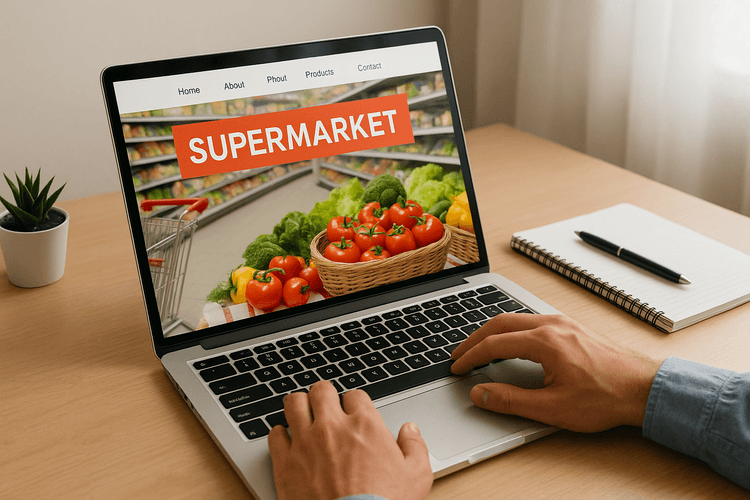
Having a website has become essential for any business, including a supermarket. In this article, we will see why it is important to create a website for your supermarket and how Framework360 can help you do it simply and effectively.
Improved online visibility
Today many consumers search for product and shop information online before making purchases. Having a website allows your supermarket to be present on the internet, increasing its online visibility and offering users a reliable source of information about your products and services.
Customer loyalty
A website allows you to keep your customers informed about new products, promotions, and events at your supermarket. Moreover, you can use tools like newsletters or campaigns with automation to retain your customers by sending them personalized offers based on their purchase preferences.
Sales growth
A well-designed website can help your supermarket to increase sales. With the ability to showcase all of the products and services you offer, users can easily find what they are looking for and purchase it comfortably from their own home. Additionally, you can integrate your website with an e-commerce platform to allow your customers to shop online.
Having a website for your supermarket is therefore essential to improve your online visibility, retain customers, and increase sales. Framework360 provides you with all the necessary tools to create a professional and functional website, customized to the needs of your supermarket.
Identification of target audience and their needs

Before starting to create a website for your supermarket, it's important to know the target audience and their needs. This will help you to create a website that is effective in meeting the requirements of your customers.
Who is your target audience?
First and foremost, you need to identify who your target audience is. If you are a local supermarket, your audience probably consists of people living in or around your area.
It can also be useful to analyze the behavior of regular customers and try to understand what drives them to choose your supermarket over others. For example, you might notice that many customers choose your supermarket because it offers local or organic products.
What does your target audience look for?
After identifying your target audience, you need to understand their needs and what they are looking for when visiting a supermarket website.
Many customers might be looking for information about the products available at your supermarket, such as prices, the origin of the food items, ingredients, or allergens contained in the products themselves.
In addition, they may look for information on current promotions, opening and closing times, or services offered by your supermarket, such as the home delivery service.
How to meet the needs of your target audience?
Once you have identified the needs of your target audience, you can create a website that is effective in meeting them.
Make sure to have detailed information about the products available in your supermarket and keep it up to date. Also, create a dedicated section for ongoing promotions and services offered by your supermarket.
It is also important to make the website easy to navigate and use so that your customers can quickly find the information they are looking for. For example, you could organize the product section into categories or create a search bar to facilitate the search for a specific product.
- Identify your target audience
- Analyze their needs and what they look for when visiting a supermarket website
- Create a website that meets their needs with detailed information on products, promotions, services offered, and ease of use of the site itself
Creation of the website architecture and selection of content to include

Before starting to create the website for the supermarket, it is important to define the website architecture and the content you wish to include. This will help organize information in a logical and consistent manner for site visitors.
Defining the website architecture
The website architecture should be designed in such a way that it ensures easy navigation for visitors. This means that visitors should be able to easily find the information they need without having to click through too many pages.
Moreover, the structure of the site should reflect the hierarchy of information within the supermarket. For example, the "Fresh Products" section could be broken down into subsections like "Fruit", "Vegetables", and "Meat".
To simplify site navigation, it is advisable to use a main navigation bar at the top of the page and a sidebar or footer to provide additional information.
Choosing the content for your website
The content of a website should be selected based on the target audience and business goals. For instance, a supermarket might want to promote certain products or special offers.
It is important to include essential information like the address of the supermarket, its opening hours, and contact methods. Moreover, the website could feature an "About Us" section to present the history and values of the supermarket.
In addition, a section dedicated to customer reviews can be an effective way to demonstrate the quality of products and services offered by the supermarket.
Examples of website architecture
- Homepage: General presentation of the supermarket
- About the Supermarket: Address, opening hours, and contact information
- Fresh Products:
- Fruit
- Vegetables
- Meat
- Grocery Department:
- Pasta
- Risottos
- Canned Goods
- Promotions: Ongoing special offers
- Customer Reviews: Comments and feedback from buyers
- Contact: Online contact form or email address for inquiries and questions
With these examples in mind, it will be possible to create a customized site architecture based on the specific needs of the supermarket.
Implementation of features such as the ability to shop online or reserve products

The ability to shop online or reserve products is a very useful option for supermarkets that want to offer their customers a convenient and flexible shopping experience. Framework360 offers numerous features to implement these options on your corporate website simply and intuitively.
Creating an online store
To create a dedicated online store section, simply click on the "Website" section in the sidebar of the control panel and choose the "Store" option. Once the store is activated, you can start adding products to your catalog, specifying their name, description, images, and price. Additionally, you will have the ability to divide products into categories and subcategories to make it easier for visitors to search for them on your website.
Shopping cart configuration
The shopping cart is a fundamental tool for all purchases made on your website. Framework360 offers a simple and intuitive shopping cart configuration, allowing your customers to add products to their cart and proceed to checkout with just a few clicks. Moreover, you can customize the cart's appearance to make it consistent with your website's design.
Booking system implementation
Framework360 also offers the possibility to implement a product reservation system, particularly useful for supermarkets that provide services such as catering or the preparation of customized gift baskets. To activate this option, simply click on the "Website" section and choose the "Reservations" option. Once the reservation system is configured, your customers will be able to select the desired product, specify preferences (for example, the number of people for whom they want to make a reservation), and complete the booking.
- To create a complete website for your supermarket, register an account with Framework360 right away at the following link: https://www.framework360.com/try-free/
- Furthermore, if you need additional information on how to create a website for your supermarket, consult our step-by-step guide at the following link: https://www.framework360.com/how-to-create-a-website/
Marketing strategies to promote your supermarket's website

Creating a website for your supermarket is just the first part of the digital adventure. Now that you have a website, you need to let people know it exists and convince them to visit it.
1. Use social media
Social media is a powerful tool to promote your website. If you don't already have a social media account, create one and start posting interesting and relevant content about your supermarket. Make sure to include the link to your website in the descriptions of your social media posts, so people can easily access it.
2. Create a newsletter
Creating a newsletter is a great way to keep your customers informed about what's new at your supermarket and about special offers. Always include a link to your website in the newsletter, so readers can visit it directly from their inbox.
3. Offer special online deals
Create special offers available only through your website. For example, you could offer a 10% discount on a specific product if purchased online. This will encourage people to visit your website and buy from you online.
4. Optimize your website for search engines
Try to position your website in the top search results on search engines like Google. This will increase the visibility of your supermarket and draw more people to your site. Use the appropriate keywords and ensure that your website is easy to navigate and fast.
5. Collaborate with other sites
Look for collaborations with other websites related to your supermarket. For instance, you could partner with a culinary blog to create a guide on how to use the products sold in your supermarket. Include a link to your website in the guide so that readers can visit it to purchase the products.
- There are many marketing strategies that you can use to promote your supermarket website: social media, newsletters, online special offers, SEO optimization, and collaborations with other websites.
- Choose the ones that best suit your needs and start promoting your online supermarket!
Monitoring results and optimizing the website

After creating your website for supermarket, it's important to monitor the results obtained and continue optimizing the site to maximize performance.
Monitoring tools
Framework360 offers a wide range of monitoring tools that will allow you to keep track of visits to your website, conversions, and other important performance indicators. Among the available tools are:
- Google Analytics: a free service provided by Google that allows you to analyze in detail the traffic of your website, traffic sources, session duration, and much more.
Website optimization
Website optimization is an ongoing process that will help you improve performance and increase the number of visitors to your site. Here are some best practices to follow:
- Site Speed: make sure your site loads quickly. Faster sites tend to have a higher conversion rate compared to slower ones.
- User Experience: make your site easy to navigate and use for visitors. Ensure the design is appealing, information is easily accessible, and navigation is intuitive.
- Quality Content: publish interesting and relevant content for your customers. This will make your site more attractive to visitors and also increase organic traffic.
In conclusion, continuously monitoring your website's results and regularly optimizing it are crucial for online success. With the right tools and by following the best practices we've discussed, you will be able to create an effective and efficient website for your supermarket. Don't forget to always keep an eye on your website's performance and make regular improvements to maximize impact on your customers!
You can do it too, you just need a lot of commitment and an excellent marketing and sales platform.
Free trial for 30 days. No credit card required.







